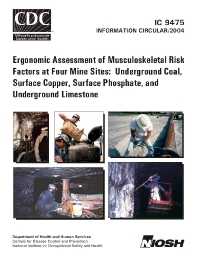Mining Publication: Ergonomic Assessment of Musculoskeletal Risk Factors at Four Mine Sites: Underground Coal, Surface Copper, Surface Phosphate, and Underground Limestone
Original creation date: August 2004
This study examined musculoskeletal injury risk at four mining sites: underground coal, underground limestone, surface copper, and surface phosphate. Each site offered opportunities to investigate musculoskeletal disorder (MSD) injury risks and how those risks might be identified and categorized. The National Institute for Occupational Safety and Health (NIOSH) worked with these sites to (1) identify work activities that showed evidence of MSD injury risk, (2) examine physical risk factors that can lead to MSDs for a handful of work tasks at each site, and (3) develop a set of ideas for problem-solving to help reduce risk factors for examined work tasks. For each site, NIOSH implemented a plan that was refined over the time period of this study. The plan consisted of four steps. The first step was to use mine injury records, a musculoskeletal discomfort questionnaire, front-line supervisor interviews, and a list of management concerns to identify work groups and work activities that have significant evidence of MSD risk factors. The second step was to select work tasks for evaluation. The third step was to interview those who do the work and make observations to characterize the MSD risk factors and musculoskeletal symptoms that exist for target tasks. The final step was to conduct brainstorming sessions with workers who perform the work or have a stake in the production task. The brainstorming sessions served to identify general strategies (ideas) for reducing MSD risk factor exposures. A final report of findings was presented to mine management and workforce representatives at each site. The risk factors and ideas for improvement identified for each site were specific to the target tasks examined. These target tasks were diverse, but there were some key similarities. For instance, jobs were found at each site that required a significant amount of manual work involving the upper extremities and low back. Handling heavy and awkward objects, forceful arm and shoulder exertions, and working in awkward postures were common for a variety of jobs across the four sites.
Authors: WJ Wiehagen, FC Turin
Information Circular - August 2004
NIOSHTIC2 Number: 20025418
U.S. Department of Health and Human Services, Public Health Service, Centers for Disease Control and Prevention, National Institute for Occupational Safety and Health, DHHS (NIOSH) Publication No. 2004-159, Information Circular 9475, 2004 Aug :1-38
See Also
- Age Awareness Training for Miners
- A Case Study of Roof Bolting Tasks to Identify Cumulative Trauma Exposure
- Practical Risk Assessment Guidelines for Identifying, Assessing, and Mitigating Stored Energy Hazards in Underground Coal Mines During and After a Mine Emergency
- Preventing Equipment Related Injuries in Underground U.S. Coal Mines
- Safety Framework for Programmable Electronics in Mining
- SPONCOM - A Computer Program for the Prediction of the Spontaneous Combustion Potential of an Underground Coal Mine
- SponCom - Spontaneous Combustion Assessment Software - 2.0
- Task Analysis
- Technology News 545 - NIOSH Updates Spontaneous Combustion Assessment Software
- Working in Noise with a Hearing Loss: Perceptions from Workers, Supervisors, and Hearing Conservation Program Managers
- Content source: National Institute for Occupational Safety and Health, Mining Program


 ShareCompartir
ShareCompartir
